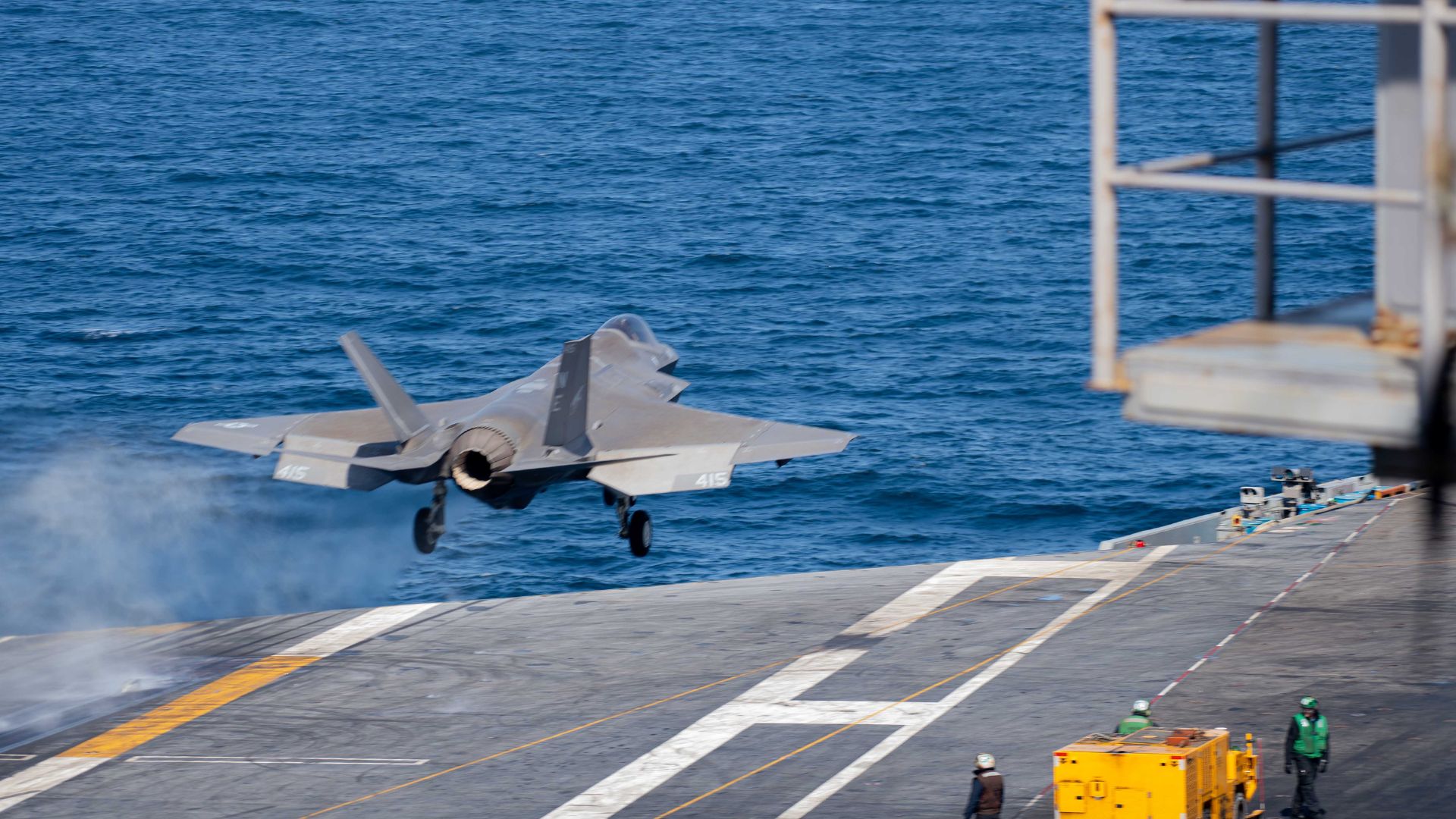The US and South Korea are currently conducting their joint Freedom Shield 25 exercise, a comprehensive 11-day military training event running from March 10 to March 21. The exercise is designed to enhance the interoperability of both nations’ armed forces and strengthen their combined defense posture in the Indo-Pacific.
As part of the ongoing training, F-35C Lightning II Joint Strike Fighters from the USS Carl Vinson (CVN-70), along with US and Republic of Korea (ROK) Air Force F-35s, have been carrying out integration training to improve coordination in air, ground, and maritime operations.
The exercise underscores the strategic alliance between the US and South Korea under the US-ROK Mutual Defense Treaty, reinforcing their readiness to respond to regional threats.
Air, Ground, and Maritime Integration
A key highlight of the recent exercise was the integration training between US and South Korean Air Forces. F-35C Lightning II Joint Strike Fighters from the USS Carl Vinson (CVN-70) participated alongside US Air Force F-35As and Republic of Korea Air Force (ROKAF) F-35As, performing combined training exercises that showcased the seamless coordination between the two nations’ advanced fighter platforms.
This multi-nation operation underscored the enhanced ability of US and South Korean forces to conduct integrated air, ground, and maritime operations, reinforcing their readiness to respond to regional threats.
The exercise’s focus on combined operations allowed both Air Forces to refine their tactics and procedures for conducting dynamic targeting, aerial refueling, and joint assaults.
This training, which also featured US Marine Corps participation, helped improve operational cohesion between the US and ROK forces, strengthening their ability to respond swiftly and decisively in a variety of scenarios.
The exercise’s air component, including F-35s from both countries, helped ensure the allies’ defense capabilities are effectively integrated across multiple domains.
🦅🛡 #FreedomShield25—Strengthening the #ROKUSAlliance
While U.S. & ROK F-35s train in the skies ✈️, this exercise integrates air, ground, naval, space & cyber—enhancing joint operations, Agile Combat Employment & real-world threat response.@7thAF @INDOPACOM @USForcesKorea pic.twitter.com/JULflAUjMO
— PACAF (@PACAF) March 14, 2025
The F-35C Lightning II, in particular, is capable of executing long-range precision strikes, making it an essential asset for securing air superiority in the region. With this exercise, both the US Navy and the ROKAF demonstrated their ability to deploy advanced air assets in unison, reinforcing the alliance’s collective defense capabilities.
Eighth Army’s Ground Component and Combined Training
The ground component of the exercise, led by the US Eighth Army alongside the ROK Army, focused on integrated training on both training ranges and within combined operations centers throughout South Korea.
Eighth Army units such as the 2nd Infantry Division, 19th Expeditionary Sustainment Command, and the 35th Air Defense Artillery Brigade participated in field training that included urban combat, field artillery exercises, air assault training, and mass casualty evacuation procedures.
One of the key objectives was to enhance the coordination between US and South Korean ground forces, ensuring seamless integration in joint operations.
The combined training scenarios in Freedom Shield 25 also included air defense artillery deployment and wet gap crossings, reinforcing the readiness of US and South Korean ground units to face various operational challenges.
The exercises emphasized the importance of interoperability and ensuring that both nations’ ground forces can act cohesively in a complex operational environment.
Aircraft from the Carl Vinson Carrier Strike Group, U.S. Air Force, and the Republic of Korea Air Force fly in formation over the Nimitz-class aircraft carrier USS Carl Vinson (CVN 70) during Exercise #FreedomShield25, March 13.
📸 MC3 Nate Jordan#USNavy | #AlliesAndPartners pic.twitter.com/MgBPV99ys3
— 7th Fleet (@US7thFleet) March 15, 2025
Royal Australian Air Force’s Regional Deployment
In addition to the Freedom Shield 25 exercise, the Royal Australian Air Force (RAAF) concluded its regional presence deployment, which included maritime surveillance missions in the South China Sea with its P-8A Poseidon aircraft.
This deployment, conducted in coordination with the Royal Australian Navy’s HMAS Hobart and multilateral partners, highlighted Australia’s commitment to maintaining security and stability in the Indo-Pacific region.
During its deployment, the RAAF Poseidon aircraft participated in a Maritime Cooperative Activity (MCA) alongside US, Japanese, and Philippine forces in the Philippines’ Exclusive Economic Zone. This multilateral exercise aimed to enhance maritime security and uphold international law.
However, tensions arose during the operations when a Chinese People’s Liberation Army Air Force (PLAAF) J-16 fighter aircraft harassed one of the Australian P-8A Poseidons by releasing flares at close range.
🇨🇳🇦🇺 Video of the Chinese J-16 fighter jet deploying flares and chaff 30m in front of the Australian P-8A Poseidon reconnaissance aircraft in the South China Sea. pic.twitter.com/uvb2YIQX0V
— Indo-Pacific News – Geo-Politics & Defense (@IndoPac_Info) February 15, 2025
The Australian government subsequently raised concerns about the incident, calling out China’s actions as a threat to regional stability.
Despite the harassment, the RAAF Poseidons continued their maritime surveillance missions, further solidifying Australia’s role in ensuring freedom of navigation in the Indo-Pacific.
The regional deployment of the Poseidons underscores Australia’s vital contribution to maintaining peace and security in the region, alongside its US and Japanese allies.
Strengthening Regional Security and Interoperability
Freedom Shield 25 and the recent Royal Australian Air Force deployment are both vital components of the ongoing efforts by the US and its allies to strengthen their combined defense capabilities in the Indo-Pacific.
The successful integration of advanced air, ground, and maritime operations during Freedom Shield 25 demonstrated the US-ROK alliance’s commitment to maintaining a robust defense posture in the face of evolving regional threats.

The joint training between US and South Korean forces, along with the participation of the RAAF, highlights the critical importance of multilateral cooperation and interoperability. As tensions continue to rise in the Indo-Pacific, exercises like Freedom Shield 25 and Australia’s regional deployments ensure that the US and its allies are prepared to respond swiftly and effectively to maintain peace, stability, and security in the region.






























COMMENTS
There are
You must become a subscriber or login to view or post comments on this article.